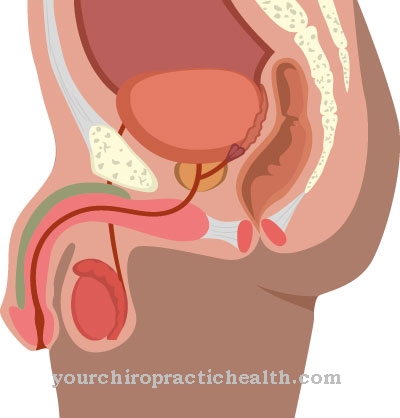The Machado Joseph Disease is a neurodegenerative disease belonging to the group of spinocerebellar ataxias. The cause of the disease is a genetic mutation that is passed on in the autosomal dominant mode of inheritance. So far, only supportive treatment methods such as physiotherapy and occupational therapy are available.
What is Machado Joseph Disease?

© designua - stock.adobe.com
Neurodegenerative diseases are characterized by pathological processes in the nervous system that cause nerve cells to lose their function. The group of neurodegenerative diseases consists of different subgroups.
One of them is the spinocerebellar ataxia 3, a group of diseases with degeneration of the central nervous system. Spinocerebellar ataxia 3 corresponds to Machado Joseph Disease (MJD). In the course of the disease, the Purkinje cells progressively decline. These are the largest nerve cells in the cerebellum and are located in the ganglionic stratum of the cerebellar cortex.
Purkinje cells are equipped with metabotropic glutamate receptors, which serve to modulate and integrate motor efferents and thus enable the learning of movement sequences. The prevalence of spinocerebellar ataxias is given as one to nine cases per 100,000 people. Machado-Joseph disease is the most common form in Germany.
causes
Machado Joseph disease is a hereditary disease. As for all other hereditary diseases, the primary cause of spinocerebellar ataxia 3 lies in the genes. An autosomal dominant inheritance applies to Machado-Joseph disease. Familial clusters were therefore observed in the cases documented so far.
A sporadic occurrence without familial accumulation is rather rare. A genetic mutation is inherited in Machado-Joseph disease. This change in genetic material affects that on chromosome 14 in the q24.3-32.1 gene locus. The gene located there no longer does justice to its physiologically intended coding and extends the polyglutamine area through the mutation.
More than a dozen different genes have so far been identified as mutation locations for spinocerebellar ataxias. In the course of MJD, unlike other forms of spinocerebellar ataxia, the mutation causes progressive degeneration of the defective Purkinje cells, which mainly leads to movement disorders.
Symptoms, ailments & signs
Machado Joseph disease patients suffer from disorders of the movement coordination center. This movement center is located in the cerebellum and is related to the Purkinje cells, which in a healthy organism control the integration of motor movement signals via their metabotropic glutamate receptors.
Since the Purkinje cells of patients with Machado-Joseph disease progressively degenerate, the motor skills of those affected are particularly disturbed. In middle age, unspecific movement disorders increasingly occur. Those affected carry out apparently nonsensical movement patterns because their control center no longer sensibly integrates the motor efferents and thus makes movement planning more difficult.
MJD usually manifests itself initially in eye movements without a logical pattern. Fixation seems to be difficult due to the movements. The further the disease progresses, the more impaired the sense of direction is.
Severe disturbances in perception add to the symptoms. Although the symptoms depend in each individual case on the severity of the course, there is usually at least a moderate disability after a certain point in time.
Diagnosis & course of disease
The diagnosis of Machado-Joseph disease is made on the basis of the clinical symptoms, with the characteristic eye movements being the main determining factor in the early stages. The family history is a crucial point in the diagnosis. The differential diagnostic differentiation of the disease from other spinocerebellar ataxias cannot be made straightforward at first glance.
Brain imaging shows typical changes within the cerebellum. A molecular genetic analysis, which provides evidence of the assigned mutation, can be used to confirm the diagnosis and to serve the differential diagnosis. The prognosis for patients with Machado-Joseph disease depends on the symptoms and the course in the individual case.
The life expectancy of those affected is usually not affected. However, multiple disabilities are to be expected for particularly severe courses, which are associated with more or less high levels of care. Lighter cases with moderate impairment in everyday life have also been documented.
Complications
As a result of Machado-Joseph disease, those affected primarily suffer from various disorders of coordination or concentration. The everyday life of those affected is significantly restricted by this disease, so that in some cases they are dependent on the help of other people. Furthermore, the general condition of the patient deteriorates in the course of the disease, so that movement disorders continue to occur.
The motor skills of the patient are also reduced and there are problems with movement planning. It is not uncommon for orientation to suffer from Machado-Joseph disease, so that those affected are often confused and do not know where they are. The exact complaints and complications, however, depend very much on the severity and general condition of the patient. As a rule, Machado-Joseph disease leads to intellectual disability in the patient.
It is not possible to treat the cause of Machado-Joseph disease. For this reason, only the symptoms and complaints can be restricted, although the course of the disease will not be completely positive. However, the life expectancy of those affected is not reduced by the disease. The patients are then dependent on various therapies that can make their everyday lives easier.
When should you go to the doctor?
If a newborn child shows mobility problems, a medical examination is required. In many cases, pediatricians or nurses can notice the first irregularities in movement immediately after the birth. You independently initiate the necessary steps for medical care in a routine process. If the first abnormalities occur within the child's growth process, a pediatrician should be consulted. If movement sequences are unusual or if they are interpreted as nonsensical by the parents, the observations should be presented to a doctor.
If eye movements are perceived to be above normal, there is cause for concern. If they don't make sense and last for several days or weeks, a medical examination is advisable. If the child has visible difficulties in planning movement or if orientation disorders are recognizable, medical help is required.
If children show problems with the fixation of objects and at the same time with their own movement sequences in reaching the goal, an illness is present. A doctor's visit is necessary so that the cause of the symptoms can be determined. A visit to a doctor is required in the event of perception disorders, learning problems or developmental delays. If, in direct comparison with children of the same age, significant differences in memory or locomotion can be determined, a doctor should be consulted.
Treatment & Therapy
Machado-Joseph disease is one of the incurable diseases. Causal therapy is therefore not available for patients with movement disorders. Causal therapies resolve the cause of a disease to make all symptoms go away.
Since the cause of spinocerebellar ataxias lies in the genes, only gene therapy approaches could offer a causal treatment and the associated cure.Gene therapy is currently a focus of medical research. However, the approaches have not yet reached the clinical phase. For this reason, patients with Machado-Joseph disease have so far only received supportive treatment.
Symptomatic treatment approaches are very limited, which is not least due to the rarity of the disease in the US and Central Europe. The supportive treatment measures primarily include physical and occupational therapy. In occupational therapy in particular, those affected learn to deal with the disease in everyday life.
The use of different aids and other compensation strategies makes everyday life easier for them and increases their quality of life. In addition, those affected are usually offered psychotherapy. Together with an experienced therapist, they deal with their illness and process the diagnosis.
Psychotherapeutic support can also be a useful step in processing for relatives. Genetic counseling is just as important for affected families. Medicinal treatment approaches to delay the course of the disease do not yet exist. However, it is speculated that regular physical therapy may delay the course.
Outlook & forecast
The outlook for people with Machado Joseph Disease is mediocre. The courses of Machado-Joseph disease vary from person to person. This disease is caused genetically. So far, the symptoms of Machado-Joseph disease can only be alleviated by helping. In addition, the hereditary disease progresses over the years. Machado-Joseph disease causes considerable disabilities and increasing mobility restrictions by mid-life at the latest. As people age, the chances of a symptom-free life deteriorate.
However, the outlook for the course of the disease depends on the symptoms present. Most often, Machado-Joseph disease does not affect people's life expectancy. The problem, however, is that there are those affected with particularly severe disease. These patients have multiple disabilities. These result in a need for care, which can be present in different degrees. The reason for this is a more or less severe disorder of movement coordination.
Despite the overall mediocre prognosis, there are also minor cases of Machado-Joseph disease documented in those affected, in which motor disorders caused moderate to moderate impairment in everyday life. The sense of direction is also increasingly disturbed as Machado-Joseph disease progresses. As the condition of those affected worsens, the degree of disability or need for care often increases in its course. As a minimum, a moderate degree of disability can be assumed in older people.
prevention
Like all other hereditary diseases, Machado-Joseph disease can only be prevented through genetic counseling in the family planning phase. Couples at increased risk may opt out of having children and adopting them.
Aftercare
Since the treatment of Machado-Joseph disease is complex and lengthy, there is no follow-up care in the strict sense. Rather, it shows up as accompanying measures to achieve a safe handling of the disease. Sufferers should try to build a positive attitude despite the difficult circumstances. Relaxation exercises and meditation can help calm and focus the mind.
As a rule, those affected are permanently dependent on the help of relatives, as everyday life is significantly restricted by the disease. The treating physicians try to limit the symptoms so that leading a normal life is made easier for those affected. Machado Joseph disease cannot be cured. Sick people have to constantly undergo various therapies so that they can lead a normal life. In order to cope better with the strains, it can help to seek psychological support.
You can do that yourself
Machado Joseph disease is a genetic disease that cannot be cured. It is progressive and leads to ataxia of the person concerned, the movement sequences are impaired.
This impairment can at least partially be counteracted with physiotherapy. It has already been shown that physiotherapy could slow the progression of the disease. It is generally important that the patient does not give up and continues to move as well as possible. The brain is also partially affected by the disease. If speaking is impaired, speech therapy measures can lead to an improvement.
Unfortunately, the progression of Machado-Joseph disease is not possible with the measures available today. Physical and mental disabilities often arise as the disease progresses. This can lead to emotional stress for the person concerned. The social environment consisting of partner, family and friends can provide emotional support for the person concerned and help them cope with everyday life. In addition, the care of a psychotherapist is helpful, as he can look after the person affected professionally during the ongoing illness. If the person concerned has a family, it is important that the family undergo genetic testing and counseling, as the disease can be genetically inherited.


.jpg)
.jpg)




















.jpg)



